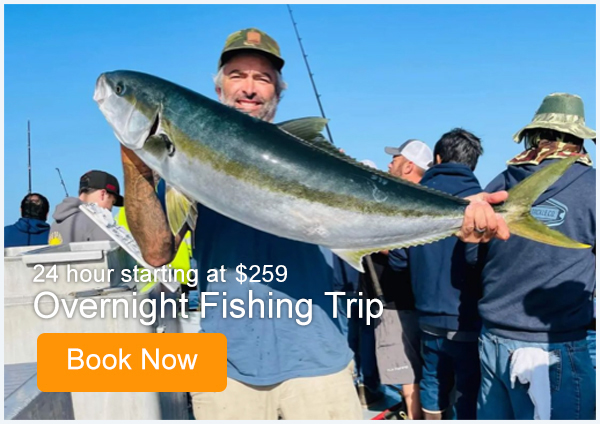Deep Sea Fishing Catalina Island
Reserve your trip online or call (949) 673-1434 to schedule
Catalina Island’s many coves and reefs provide an amazing fishing habitat. Within the reefs, there are schools of bait fish like anchovies, sardines, and mackerel. The bait fish attract larger sport fish like White Sea Bass and Yellowtail. When the waters warm up, you may even have a chance to catch Marlin, Bluefin Tuna, or Yellowfin Tuna while enjoying Catalina Island fishing.
[View Pricing and Trip Lengths]

Early fishermen at Catalina Island used heavy lines and could catch an abundant amount of Albacore, which were considered inedible and were thrown to the seals. The Tuna Club was established by Charles Frederick Holder on Catalina Island in 1898. Holder was a respected angler from the East Coast who traveled in search of large game fish. Charles was the first to introduce rod and reel in big game fishing on Catalina Island. Rod and reel gave the fish more of a fighting chance, making it more of a sport for some. Charles and his friends established the Tuna Club to promote sportsmanship and conservation on Catalina Island. In 1908, they built a clubhouse that created rules and regulations for fishing. It is one of the most prestigious sport fishing clubs in the world. In 1913, Catalina Island became incorporated as a resort community. Fishing and deep-sea fishing trips became a popular activity for many visitors. Many boatmen opened businesses for charters to go out in search of the many elusive game fish that swim in the waters of Catalina Island.
Catalina Island Fishing in Spring

 Spring fishing at Catalina Island starts picking up on March 1st when Rock Fishing season opens. You can catch any of the fish below, but will range from 1-6lbs, Lingcod can get up to 15-20lbs and Halibut and White Sea Bass can get up to 50lbs.
Spring fishing at Catalina Island starts picking up on March 1st when Rock Fishing season opens. You can catch any of the fish below, but will range from 1-6lbs, Lingcod can get up to 15-20lbs and Halibut and White Sea Bass can get up to 50lbs.
Rockfish – Rockfish is a commonly used name for a number of species. They have a regulated fishery which begins March 1st though December 31st.
Bocaccio – Also known as a Salmon Grouper. The Bocaccio’s main food source includes mackerel, anchovies, sardines, perch, squid, octopus, crab, and other small fish. You can usually find Boccaccio in deep rocky environments. Bocaccio are part of the rockfish family and is closed for fishing January 1st through March 1st. Bocaccio spawn between December and April.
Whitefish – Whitefish can be caught from central California to Peru. They are found on sandy, muddy or rocky seafloors. You can catch from depths from 30 to 300 feet deep. The largest Whitefish caught is 13lbs, but the average size would be around 4 -5lbs.
Sanddabs – Sanddabs are part of the flounder family. They have both eyes on the left side of their head. They are found in deep waters on a sandy bottom.
Sargo – Sargo are found close to land and can be cost mostly in waters up to 40ft deep. You want to fish for rocky bottom to sandy floors. You can catch Sargo in the summer months and you can use clams, mussels, shrimp, or cut bait.
Blue Perch – You can catch perch in shallow waters up to80 feet deep. Perch like to feed on plants most anglers can catch perch using anchovies or striped squid.
Vermilion Rockfish – Also known as Red Snapper. Young Red Snapper primarily feed on shrimp -like organism, while adult red snapper feed on squid, octopus, and other rockfish. The spawn season is from December to March. Red Snapper are considered a rockfish and is closed to fishing from January 1st and opens March 1st. You can fish for Red Snapper on any rocky bottom deeper than 100ft.
Cabezon – Cabezon feed on crustaceans, mollusks, fish, and fish eggs. Cabezon inhabit the tops of rocky ledges. Cabezon fishing is closed from January 1st to March 1st.
Sheepshead – Sheepshead don’t make long sustained runs like yellowtail or other gamefish at Catalina Island do, but they use every ounce of their body to try and pull you down into the rocks where they can break you off. Sheepshead love feeding on hard -shelled animals. Most anglers prefer using shrimp as bait drifting over reefs using a sliding egg sinker in shallow water and a reverse dropper loop in deeper water.
Sculpin – Also known as a California Scorpionfish. The sculpin’s main food source includes crab, squid, octopus, shrimp, and other smaller fish. You can usually find sculpin in shallow rocky areas. There spawning season takes place from April through August. Sculpin have poisonous spines on the top of their body which causes severe pain at the wound. There are many treatments, but soaking it in hot water seems to be the most effective.
Calico Bass – Also known as kelp bass. Calico Bass live in kelp forest. They range from 1 -3lbs but can reach double digits. Fishing for calico bass can be frustrating at times. If you not paying attention they will swim back into the kelp and wrap your line up which makes it difficult to get them out. Most people fish 15 -30lbs test for calico bass. Calico bass feed on anchovies, sardines, squid, and other small bait fish. Most people will use a flyline or sliding egg sinker with an anchovy or sardine. Another technique is using a leadhead with a Squid
Sand Bass – Sand Bass range from 1 -3lbs but can reach double digits. Sand bass can be found in 60 -100ft of water along sandy bottoms. Most people use 15 -25lbs line, but when fishing in structure it is nice to have heavier line. The most commonly use bait is anchovies and sardines with a small sliding egg sinker or no weight at all. You can also you fresh dead squid on a dropper loop or a leadhead.
Lingcod – Lingcod are extremely aggressive and predatory fish. The Lingcod habitat is a rocky bottom where there are massive boulders and cliffs with crevices. Lingcod lie in wait for their prey to swim by. Best technique for fishing lingcod would be fishing on the drift from the shallow water to deeper water to avoid snagging the bottom.
White Seabass – White Seabass can be found of the coast of Catalina Island around the squid nests. Best time to catch White Seabass is early morning. They can grow up to 60lbs, but the average is 20 -30lbs.
Halibut – Halibut are a large -tooth flounder and typically feed towards shore. They range from 6 -50lbs. You can fish for halibut using anchovies, sardine, squid, and mackerel. Most halibut are caught in 10 -80ft of water.
Yellowtail – Spring yellowtail fishing usually begins in March at Catalina Island. ¾ day boat and overnight boats are able to target these fish during this time. Fishing in a warmer season Yellowtail like to feed on fin bait such as sardines, anchovies, and sometimes mackerel, but during cooler years you may need to use live squid to get the yellowtail to feed.
Catalina Island Fishing in the Summer
Reserve your trip online or call (949) 673-1434 to schedule

Summer fishing at Catalina Island can bring a lot of excitement for the day. You can catch a variety of fish from Bass to Yellowtail, Tuna, and Dorado. Most summer fishing is done of the surface using Irons, Flyline Live Bait, or Sliding Egg Sinkers. The first gamefish that starts biting is usually Yellowtail when the water gets around 65 degrees.
Yellowtail – Summer yellowtail is known for huge quantities of yellowtail being caught from Overnight trips to ¾ day trips and even on half days sometimes. During the months of June, July, and August you can catch yellowtail in a number of different area from Floating kelp paddies, to local islands, to coastal areas and reefs. You can catch yellowtail on live bait, artificial jigs, or Iron jigs.
Bluefin Tuna – Bluefin Tuna are caught in the early months of summer usually starting in June off the coast of Catalina Island. Bluefin tuna are one of the most sought out gamefish there is. Bluefin Tuna can get over 100lbs, but the average you will see is 20 -50lbs. Bluefin tend to be a surface fish that tend to feed on live bait or jigs. You can also fish for tuna in waters deeper than 100ft using a dropper loop technique.
Yellowfin Tuna – Yellowfin Tuna are caught later in the summer in July and August off the coast of Catalina Island. They range from 8 -50lbs. Yellowfin Tuna can be found offshore of Catalina Island around the 14 mile bank. You can find them on meter marks or off of kelp patties. You can fish for yellowfin tuna with live bait or jigs.
Skipjack Tuna – Skipjack Tuna are caught usually mixed in with Yellowfin Tuna and range from about 5 -10lbs.
Dorado – Dorado can be caught off the coast of Catalina Island in the late summer when the water temperature is the warmest. Dorado are known for their aerial acrobatics and their ability to change colors. You can see Dorado in a vibrant gold, yellows and greens flecked with blue. These colors changed on the fish’s mood. They tend to be yellow and green when they are exciting, but when they get onto the boat they quickly loose there color and revert back to their silver -grey color.
Barracuda – Barracuda can be found in the shallow waters off of Catalina Island. You can find them in huge schools on the front side of Catalina Island. Barracuda are extremely aggressive fish and will bite almost anything. The two most efficient way are live bait and irons. When using live bait most people will recommend using a wire leader, so that the barracuda can’t bite through the line. Using just monofilament brings a better chance for the barracuda to bite through the line and break free. Fishing the Iron can be exhilarating as you are winding the iron in you may get a bite at anytime
Bonito – Bonito can be found in any warm water area. You can catch them off the pier of Catalina Island or anywhere off the coast. Bonito feed on small bait fish such as anchovies.
Calico Bass – Calico Bass can be caught in the shallow waters around Catalina Island. Best method for catching Calico Bass is to use live bait while flylining.
Striped Marlin – Striped marlin is found in warm tropical waters. They can reach u to 420lbs and can get up to 13ft long. They feed during the day in the top 100 meters of the water column often near the surface. One of their chief prey is sardines.
Blue Marlin – On average blue marlin usually reach 11ft in length and weigh up to 200 -400lbs. Females can grow to be 3 times larger than males. Most Blue marlin are caught trolling of the coast of Catalina Island. When trolling you want your lure anywhere from 20ft to 100ft depending on the boat you are on. You also want to make sure you have a staggered pattern of fish so it looks like a school of fish behind your boat.
Blue Perch – You can catch perch in shallow waters up to80 feet deep. Perch like to feed on plants most anglers can catch perch using anchovies or striped squid.
Catalina Island Fishing in the Winter
Reserve your trip online or call (949) 673-1434 to schedule

Winter fishing around Catalina Island can be pretty tough at time. When fishing in the winter at Catalina Island you really need to get when the weather is perfect and you have the correct bait. Your best chance would be getting live squid from a bait barge or being at the Island in the middle of the night to make bait, but if you have the right bait you can make a day out there catching Calico Bass and Blue Perch and sometimes even Yellowtail depending on the water temperature. The average water temperature in the winter is 59-65 degrees.
Calico Bass – Calico Bass can be caught off the coast of Catalina Island, but are usually not as active because of the cooler temperature.
Blue Perch – You can catch perch in shallow waters up to80 feet deep. Perch like to feed on plants most anglers can catch perch using anchovies or striped squid.
Catalina Island Deep Sea Fishing Locations
Church Rock – Church rock is in an area known as the East End of Catalina Island and encompasses the area from the Southern California Edison power plant east of Avalon and to Catalina Island’s southeast point. Barracuda, White Seabass, and Yellowtail start showing in local waters here and many will stay for long periods. The underwater seamount off the rock face and the kelp bed make great areas for fishing.
Farnsworth Bank – Farnsworth Bank is a Marine protected area that prohibits the taking of all living marine resources except the recreational fishing for Bonito, White Seabass by spearfishing, Marlin, Tuna, and Dorado by rod and reel. The rocky reef, kelp forest, and emergent rock habitats support specials of invertebrates, plants, fish and marine mammals.
14 Mile Bank – The 14 mile bank like its name is just 14 miles from the entrance of Newport Harbor. The 14 mile bank has been known to produce good amount of Marlin, as well as Tuna in the summer months.
Techniques
Flyline – Flyline fish is used when you are using live bait. All you are using is a hook with no weight and you are letting your bait swim as freely as possible.
Dropper loop – Dropper Loop consist of a weight on the bottom with a hook about 1 foot above it. You usually use this technique for deeper water fishing.
Reverse Dropper Loop – Reverse Dropper Loop consists of a weight on the top with a hook on the end. Most people will use this to fish for Sand Bass and Halibut.
Lead Head – Lead head fishing is real popular in southern California and Catalina Island, people fish leadheads. You can use a squid
Sliding egg sinker
Types of Bait
Anchovies – Most anglers fish anchovies with no weight which is called flylining. Most anglers using anchovies use are about 3 -6 inches and can be at times difficult to fish. Most anglers will hook an anchovy through its gill plate, nose, or butt.
Sardine – Sardines are roughly about 4 -7 inches an can be used for fishing big game. You can nose hook them is the easiest way to fish a sardine, but it also hinders that fishes swimming ability. The other way is to butt hook him. This allows him to have a more free swimming motion. You can also cut the sardine in strips and use it as cut bait if you are not fishing for big gamefish. You can fishing sardine using a sliding egg sinker, fly line or dropper loop.
Mackerel – Mackerel is the easiest and most accessible bait to use. Mackerel are the perfect target to teach beginning anglers how to fish in the sea. When they are in a feeding mood, they will bite about anything that is put into the water. You can use them as bait also and fish them just like you fish sardines or anchovies. Newer anglers like to use mackerel because they tend to swim much better being attached to line, but sometimes they are too big for gamefish. Tuna and Yellowtail tend to prefer anchovies or sardines, so even though you mackerel may be easy to fish it is not always the best.
Squid – You can fish live or fresh dead squid. Most will fish using a sliding egg sinker or a lead head. If you are fishing for Early Yellowtail or White Seabass Squid is the best bait to use. The best way to hook a squid is to put it through the mantle 3 times as close to the top as possible to allow it to still have the end hanging.
Catalina Island Boat Charters – Davey’s Locker
Booking a deep sea fishing charter with Davey’s Locker means you have options. When you visit the west coast of Southern California for Catalina Island fishing and book with the Davey’s Locker crew, here are the boat options you’ll have:
Freelance – Freelance is the ¾ fishing boat out of Davey’s Locker. They run private party charters starting at $3,865 and up to $5,500. The price includes the boat for your group only, a captain, and crew members. The Freelance is an 80’ x 24’ fishing vessel that can fish up to 80 people. The freelance has a spacious galley/snack bar with seating up to 30. It is ideal for large groups and company outings.
Western Pride – Western Pride is a ½ or ¾ fishing boat out of Davey’s Locker. They run private party charters starting at $1,640 up to $5,265. The price includes the boat for your group only, a captain, and crew members. The Western Pride is a 75’ x 22’ fishing vessel that can fish up to 80 people. The Western Pride has a spacious galley /snack bar with seating up to 30. It is ideal for large groups and company outings.
Thunderbird – Thunderbird is an overnight fishing boat out of Davey’s Locker. They run private charters starting at $4,900 up to $5,500. The price includes the boat for your group only, a captain, and crew members. The Thunderbird is a 65’ x 18’ fishing vessel that can fish up to 30 people. The Thunderbird is equipped with a large bait tank and a brand new RSW fish hold. With the new fish hold you can now arrive out the docks with your fish in prime condition.
Bongos III – Bongos III is a 6 pack charter boat out of Davey’s Locker. Bongos III is a 38’ Tiara Express, powered by twin Cummin Turbo diesel engines that cruise at 22 knots. It is equipped with state of the art electronics a galley with a microwave, private head, full bed, and all required safety equipment. It is specialized in overnight and ¾ day trips. Trips start at $1,445 up to $3,180.
Bongos II – Bongos II is a 6 pack charter boat out of Davey’s Locker. They are equipped with state of the art electronics and a cruising speed up 22 knots. It has a private head and bed. They have top of the line fishing equipment and can fish all around the coast of Southern California, and can get to Catalina in about an hour at cruising speeds.
Tailchaser – Tailchaser is part of Davey’s Locker 6 pack fleet. It has a bed and bathroom on the boat and is equipped state of the art electronics and supplies all fishing equipment needed for your trip.
Aggressor – Aggressor fishes from ½ day trips up to overnight trips out of Davey’s Locker. They run private charters starting at $$1,490 up to $4,070. This price include the boat for your group only, a captain, and crew members. The Aggressor is a 65’ x 19’ fishing vessel that fishing 48 on day trips and 24 on overnight trips. The Aggressor is perfect for small groups of friends or small company outings.
HALF-DAY FISHING TIMES & PRICES

Standard Departures: 6:00 am | 9:00 am | 12:30 pm | 7:00 pm
Limited Load Departures: 5:55 am | 8:55 am | 12:25 pm | 6:55 pm
(Up to 50% less passengers as standard trip allowing for ample fishing space)
Duration: 5 to 6 hours
Species: Bass, Sheephead, Sculpin, Bonito, Barracuda, White Sea Bass, Mackerel
| Trip Type | Price |
|---|---|
| Standard Adult (Ticket Only) | $50.00 – $65.00 |
| Standard Junior or Senior (Ticket Only) | $40.00 – $55.00 |
| Limited Load – All Ages (Ticket Only) | $70.00 – $90.00 |
| Add On Rod Rental & Tackle Pack To Any Ticket | $32.00 |
| Add On a One Day Fishing License To Any Ticket | $20.52 |
| Fishing License Required for Ages 16+ | |
Half-Day Fishing Rates >> Reserve Now
3/4 DAY FISHING TIMES & PRICES

Standard 3/4 Day Duration: 7:00am – 5:00pm
Extended 3/4 Day Duration: 6:30am – 6:30pm
Limited Load Extended 3/4 Day Duration: 6:00am – 6:00pm
(Up to 50% less passengers as standard or extended trip allowing for ample fishing space)
Species: Yellowtail, White Sea Bass, Bonito, Barracuda, Calico Bass, Sheephead, Sculpin
| Trip Type | Price |
|---|---|
| Standard Adult (Ticket Only) | $74.00 |
| Standard Junior or Senior (Ticket Only) | $64.00 |
| Extended Adult (Ticket Only) | $99.00 |
| Extended Junior or Senior (Ticket Only) | $99.00 |
| Limited Load Extended All Ages (Ticket Only) | $105.00 – $135.00 |
| Add On Rod Rental & Tackle Pack To Any Ticket | $32.00 |
| Add On a One Day Fishing License To Any Ticket | $20.52 |
| Fishing License Required for Ages 16+ | |
3/4 Day Fishing Rates >> Reserve Now
Gunny sacks and fish cleaning are an additional fee on board
OVERNIGHT FISHING TIMES & PRICES

Duration: 9:00pm – 7:00pm
Species: Yellowtail, white sea bass, yellowfin tuna, albacore tuna, bluefin tuna, dorado, and more
| Trip Time | Price |
|---|---|
| 9pm – 7pm | $159 – $269 |
Our Overnight/Multi-Day trips have the ability to fish in Mexican fishing waters; if they choose to do so, we will make you aware before the trip departs and a 1-Day Mexican fishing license will be required to be purchased at check-in prior to departure.

Another amazing day out on the water. Caught some fish lately?
A post shared by Davey’s Locker (@daveyslockersportfishing) on
A post shared by Davey’s Locker (@daveyslockersportfishing) on
Just another epic day at Davey’s Locker
A post shared by Davey’s Locker (@daveyslockersportfishing) on
Lingcod series #fishingdiaries // March ’17
A post shared by Davey’s Locker (@daveyslockersportfishing) on
5 for 15 on trophy fish. Biggest one taped at 183 lbs. (8/2/17)
A post shared by Davey’s Locker (@daveyslockersportfishing) on



